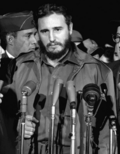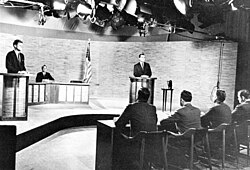Bay of Pigs Invasion
Lua error in Module:Location_map at line 50: attempt to call local 'map' (a nil value). During the Bay of Pigs Invasion (April 17, 1961), the United States government and 1,400 Cuban exiles tried to invade Cuba and remove Fidel Castro from power.[4][5][6] The invasion happened at the Bay of Pigs on Cuba's southern coast.
The invasion went wrong almost from the start, and it was defeated in two days.[6] It was one of many attempts the United States Central Intelligence Agency (CIA) made to remove Castro from power. They were never successful.
Purpose
The invasion happened during the Cold War, which was partly a conflict between capitalist and communist countries. Castro was a communist, and his government allied with the Soviet Union. The United States, a capitalist country, opposed the Soviet Union and its allies. The CIA wanted to remove Castro so that a non-communist government could take over.[7][8]
Meanwhile, the Cuban exiles wanted to overthrow Castro so they could return to Cuba.
United States President Dwight D. Eisenhower initially planned the invasion.[7] In 1961 John F. Kennedy replaced Eisenhower and found out about the plan. He launched the attack just three months after he was inaugurated as President.[9]
Failure
The invasion failed quickly for many reasons.[8]
Under the original plan (developed during the Eisenhower administration), U.S. air and naval forces needed to support the exiles during the invasion. However, as the invasion began to fail, Kennedy decided not to give any more air support.[10] The invasion's landing site was also changed.[10]
The original plan also assumed that Cuban people, and parts of the Cuban military, would rise up and help to defeat Castro. However, Cuban people did not support the invasion as much as the CIA had expected.[5]
Also, Cuba knew ahead of time that the invasion was coming. Intelligence sources, including the Soviet Union, found out about the planned invasion and warned Cuba. For this reason, the Cuban Army was ready.[11]
The invaders did not get far into Cuba. Over 100 were killed, and almost 1,200 surrendered.[5] They were kept in jail for 20 months while the United States negotiated with Castro. Castro eventually released them in exchange for USD $53 million worth of baby food and medicine.[5]
Bay Of Pigs Invasion Media
Provisional President of Cuba Manuel Urrutia with rebel leaders Che Guevara and Camilo Cienfuegos, 1959
Cuban Army officer Huber Matos after his arrest, being transported to La Cabaña
John F. Kennedy answered difficult questions on Cuba on 12 April, only five days before the invasion.
Douglas A-26 Invader "B-26" bomber aircraft disguised as a Cuban model
Related pages
References
- ↑ 1.0 1.1 1.2 Szulc (1986)
- ↑ 2.0 2.1 FRUS X, documents 19, 24, 35, 245, 271.
- ↑ Quesada 2009.
- ↑ "Bay of Pigs Invasion and the Alabama Air National Guard". Encyclopedia of Alabama. Retrieved 2024-09-27.
- ↑ 5.0 5.1 5.2 5.3 "The Bay of Pigs | JFK Library". John F. Kennedy Presidential Library and Museum. Retrieved 2024-09-27.
- ↑ 6.0 6.1 "The Bay of Pigs Invasion and its Aftermath, April 1961–October 1962". United States Department of State Office of the Historian. Retrieved September 26, 2024.
- ↑ 7.0 7.1 Pfeiffer, Jack B. (December 1979). "Official History of the Bay of Pigs Operation - Volume III: Evolution of CIA's Anti-Castro Policies, 1959 - January 1961" (PDF). Central Intelligence Agency.
- ↑ 8.0 8.1 "Bay of Pigs: A Case Study in Strategic Leadership and Failed Assumptions". The Strategy Bridge. 2017-05-02. Retrieved 2024-09-27.
- ↑ Gellman, Irwin F. (2015-12-05). "It's Time to Stop Saying that JFK Inherited the Bay of Pigs Operation from Ike". History News Network. Retrieved 2024-09-27.
- ↑ 10.0 10.1 "Bay of Pigs: The 'Perfect Failure' of Cuba Invasion" (in en-GB). BBC News. 2011-04-14. https://www.bbc.com/news/world-latin-america-13066561. Retrieved 2024-09-27.
- ↑ Vandenbroucke, Lucien S. (1984). "Anatomy of a Failure: The Decision to Land at the Bay of Pigs". Political Science Quarterly. 99 (3): 471–491. doi:10.2307/2149944. ISSN 0032-3195.








